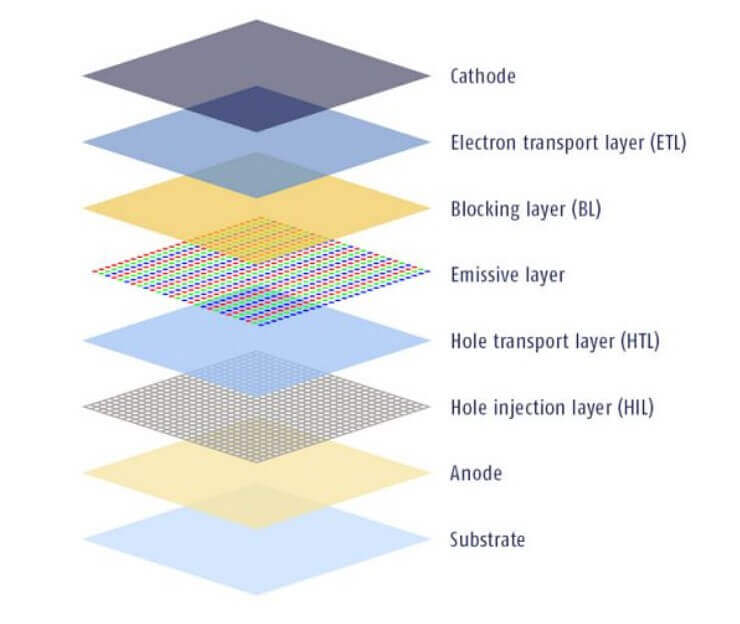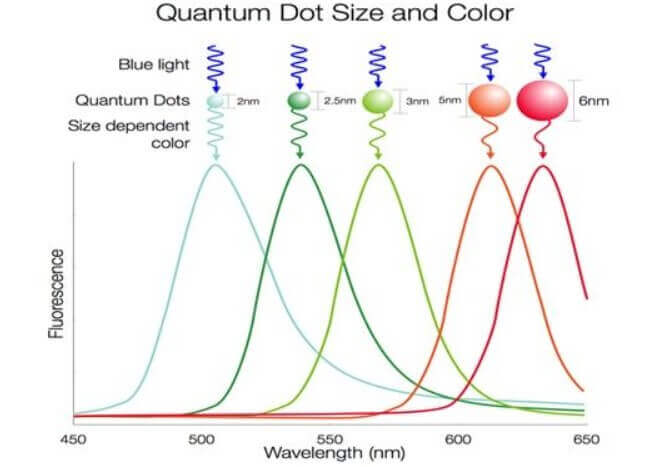Main differences between QLED and OLED technologies for monitor and TV panels.
The technology OLED ( Organic Light Emitting Diode ) begins now to be rather known: instead of using an array of white LED lights that illuminate the panel’s pixels, in the case of OLED is used a process called electroluminescence, property owned by some organic elements.
View more: OLED vs QLED which is better?
In OLEDs, each pixel lights up independently, and there is, therefore, no need to apply a fixed backlight. The advantage is that blacks will come out much deeper and lower energy consumption than conventional monitors and LED TVs.
Furthermore, by not using a rear matrix of LEDs, OLED screens can also be made using flexible panels.
Among the main disadvantages is that OLED technology uses organic materials, which have an expiration date as they are perishable. OLED monitors and TVs produced today will no longer work within a couple of decades, at most.

Structure of OLED panels
The technology Samsung QLED has been developed by the South Korean manufacturer at the beginning of 2017 as an evolution of technology quantum dot and is set to compete with OLED technology, “feud” LG and Sony.
QLED, which stands for ” Quantum dot LED “, maintains a LED lighting matrix, unlike OLED panels. In this case, however, nanoparticles are used (hence the name), tiny crystals that intervene on the blue and obtain a pure white light.
As in OLEDs, each pixel is individually illuminated, but specific pure colors can be emitted. By varying the nanoparticle’s size, in the QLED panels, the color of the light emitted can be changed, thus generating truly saturated primary colors (thanks also to the removal of the yellow phosphor, which usually prevents the achievement of this goal).

It must be said that OLED today represents a bit of the status quo: LG has made billionaire investments in this technology, and White OLEDs (W-OLEDs) are destined to remain the reference point for the next few years.
In OLED panels, each pixel comprises three subpixels that emit the three colors R, G, and B. After quite a long time, color rendering and brightness tend to diminish. The W-OLED approach uses a single white emitter (hence the name) in front of which small lenses (R, G, B filters) are positioned. In this way, the panel manufacturer can avoid pixel decay even if it will still be necessary to consider a certain loss of brightness after at least 15 years, depending on the uses.
However, the filters placed in front of the emitter limit the maximum brightness obtainable compared to more traditional panels.
QLED vs OLED: Who Wins?
The contrast is the difference between the darkest part of an image and the lighter one. If a panel can deliver a pure black color, there is no need for bright parts to glow too much to maintain a decent contrast level.
From this point of view, OLED panels have a huge advantage over QLEDs as they can show “naturally” pure blacks.
Speaking instead of brightness, the speech changes. Since QLED panels depend on an LED backlight matrix, they have a big advantage in terms of the intensity of the light they can emit over the individual LED lighting of OLED screens. Therefore, the maximum brightness of these screens is much higher than that of the OLED panels, not to mention the W-OLEDs.
The response time is when it takes for a pixel to pass from one state to another: as the value decreases, the sharper the image produced will be, especially in fast and action scenes. At the moment, OLED panels are vastly faster than QLEDs. The same important advantage for OLED panels is recordable in the refresh rate(number of times per second that the image is updated on the screen), which can push to higher values.
In terms of viewing angle, OLED panels can be viewed with 100% sharpness at angles up to 84 degrees. It is not a hair-pulling value and certainly not comparable to the performance ensured by IPS LCD panels with LED backlighting (see also PC Monitor: which to choose ). Still, OLEDs are certainly better than QLEDs today.
OLED panels are extremely thin and lack LED backlighting: unlike QLEDs, they require much less power to operate (about 40% less for the same size) and are therefore also more efficient from the point of view of energy consumption.
In terms of color space, the OLED and QLED panels show quite similar characteristics for the moment, with a really interesting color rendering in both cases. However, with an OLED, it will never be possible to cover the Rec2020 color space.
Substantial “balance” between OLED and QLED regarding the input lag that is the delay between the execution of an action (for example, the pressure of a key on the keyboard or mouse) and the visualization of the result.
Speaking of size, to win hands down, today, are the QLEDs that arrive at 100 inches diagonal and more (obviously at unrealistic costs for “mere mortals”). In the case of OLEDs, LG Display has already pointed out that it will move its current 77-inch stick even higher.
Compared to lifetime, according to LG, OLED displays can withstand 5 hours of daily use for 54 years before maximum brightness reaches 50% of factory brightness. The real data, it must be said, are to be considered decidedly further than what was stated.
The burn-init is the effect that, following prolonged display in the same position of an image or, for example, of a logo, a “ghost image” is generated, which continues to appear superimposed on the screen.
QLEDs are not subject to this problem, while OLEDs can, unfortunately, manifest it ( this simple video, enlarged to full screen, allows you to identify the OLED panel areas affected by burn-in thanks to the use of a red frame).

A tech-savvy writer with a knack for finding the latest technology in the market, this is what describes John Carter. With more than 8 years of experience as a journalist, John graduated as an engineer and ventured soon into the world of online journalism. His interest includes gadget reviews, decoding OS errors, hunting information on the latest technology, and so on.













